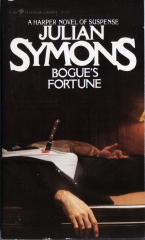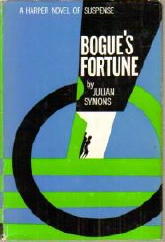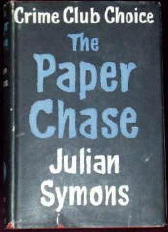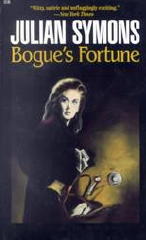Sat 14 Jun 2008
JULIAN SYMONS – Bogue’s Fortune.
Perennial Library; paperback reprint, 1980. Harper & Brothers, US, hc, 1957. Other US paperback editions under this title: Dolphin, 1961; Carroll & Graf, 1988, 1993. First published in the UK as The Paper Chase: Collins Crime Club, hc, 1956. Paperback reprints under this title: Fontana, UK, 1958, 1966; Corgi, UK, 1970; Beagle, US, 1971.

This is the book I began reading immediately after I finished The India-Rubber Men, by Edgar Wallace, and reviewed here not too long ago. It is also the book that I contrasted the Wallace book to in the comments that followed, saying:
“Symons’ story is witty and clever, and filled with engaging people — some of whom are obviously wrong-intentioned or have taken wrong turns in their life — but still engaging. The story line is filled with puzzling events that make me (the reader) want to keep reading to see what comes next, and this is the test where I think The India-Rubber Men comes up short, or at least it did with me.
“(So far I’ve only just begun Symons’ book, but neither did I turn out the light on it when it got late last night, as I did a number of times with the one by Wallace.)”
I confess that I got sidetracked in reading Bogue’s Fortune – since the time I started the book and now, my wife and I have been watching the entire 13-episode season of Eli Stone on DVD, not crime-related but we both think it’s a fabulous show. But I finished the book in one last gulp last night, closing the pages around 2 a.m., and now here I am and ready to report.

Don’t expect a long analysis of all of Symons’ work, however, or any, for that matter. This is the first one I can recall ever having read, but no matter if it’s typical of his crime fiction – and I suspect not – it will not be my last.
He was in thriller mode when he wrote this one – which is what brought up the comparison with Edgar Wallace in the first place – and I’m sticking with my original impression. It’s witty and clever, and filled with engaging people, as I said earlier.
The story – at least he’s getting to it, you say, and I am – begins with a chap named Charles Applegate about to embark on a new career, that of instructor at Bramley, an ultra-progressive school for delinquent children somewhere outside of London. He has an ulterior motive, as he is no teacher, only a detective story writer looking to place his next mystery in such an establishment.
After some hugger-mugger on the train down, his first night at the school is marred by the discovery of his also newly-arrived colleague dead in the victim’s own bed in the room next door. Murder it is, committed with the knife that Applegate took from one of the students around meal time the evening before.
This all in the first 50 pages, and by page 72 he is having the following conversation with Hedda Pont, the young matron of the school and the niece of the director. She is as equally progressive as the school, which of course part of her charm to Applegate:

“The police.” Applegate was quite disconcerted. “Do you know, that never occurred to me. I should have rather a lot of explaining to do.”
“That’s wonderful. Let’s do some investigating on our own.” Her blue eyes were bright as tinsel. Was it significant, Applegate wondered, that this should be the simile that occurred to him?
Not surprisingly, perhaps, it is Hedda who has a better head on her shoulders for detecting than does Applegate, and perhaps even more physically active in the case that follows as well. One begins to think that Symons is being a bit satirical here, and once started thinking in this direction, one cannot begin to stop. Nor should one, and the way the ending plays out will only reinforce that thought.
I do not think that Symons was thinking so much of Wallace when he write this, however, and while I am also not so very familiar with John Buchan, the latter’s name is invoked on page 135, in the following conversation that closes Chapter 16:

“Do you know the most fascinating thing of all?” Her voice came from the darkness.
“What’s that?”
“The face peering from the tower. And the man with the lobe missing off his ear. Positively too John Buchan for words.”
Don’t get the wrong idea from the first sentence in that last selection. Hedda’s previous sentence had been, “A girl just can’t be ardent all the time. Will you turn out the light? Good night.”
While both the beginning and end of this thriller adventure, combined with a little bit of detection, meet my prior expectations and then some, the middle sags a little, beginning with a 20 page exposition of the facts of the matter by one of the participants on the adversarial side, or at least his version of them, and no, it is not really known for a while whose side he is on, besides his own, and the jury may safely disregard this entire remark – or at least the second half of it.
The overall rating, then, if I were to give one, still averages out to much better than average. Much. (And if you were to ask, I would have to say that the US title is the better one. By far.)
June 14th, 2008 at 3:06 pm
Symons was one of the writers I read voraciously 35 years ago. Always sad when I see these largely forgotten writers: Nicholas Blake another.
June 14th, 2008 at 4:25 pm
Patti —
I know what you mean. I’d put Michael Innes in the same category, although I’m sure none of them wrote anything like the others.
But thanks for giving me the push I needed to post a review of The Private Wound, which as it turns out, was the last mystery Nicholas Blake wrote, and perhaps his least typical.
I’m not sure about that last statement, but I’ll have another Blakian review to be posted soon, this one a lot more in the classical Golden Age vein, especially with Nigel Strangeways the detective on the case.
— Steve
January 24th, 2009 at 4:59 pm
Comparing critic Julian Symons to Edgar Wallace is hardly fair to either man. Wallace was a newspaper man and race track tout with a facility for spinning yarns, Symons a critic of the genre (and literature in general) and serious writer. You are essintially trying to compare Sax Rohmer to Graham Greene, writers who had virtually nothing in common but the language and the genre.
Symons is an outstanding writer and managed to write everything from historical mystery to humor to suspense to spy novels and classical detection. You might also seek out some of his short stories, especially those about British private detective Francis Quarles.
Of his later books, The Blackheath Posionings was a great success, and any fan of the genre should read his book on the genre Mortal Consequences. He also did an entertaining and handsome coffee table book featuring stories by him about Sherlock Holmes, Miss Marple, Poirot, Maigret, Philip Marlowe, and Nero Wolfe, all handsomely illustrated with color paintings. All his books are worth reading, but don’t expect him to repeat himself. Every book is unique.